Customer experience automation: The complete guide to CXA in 2025
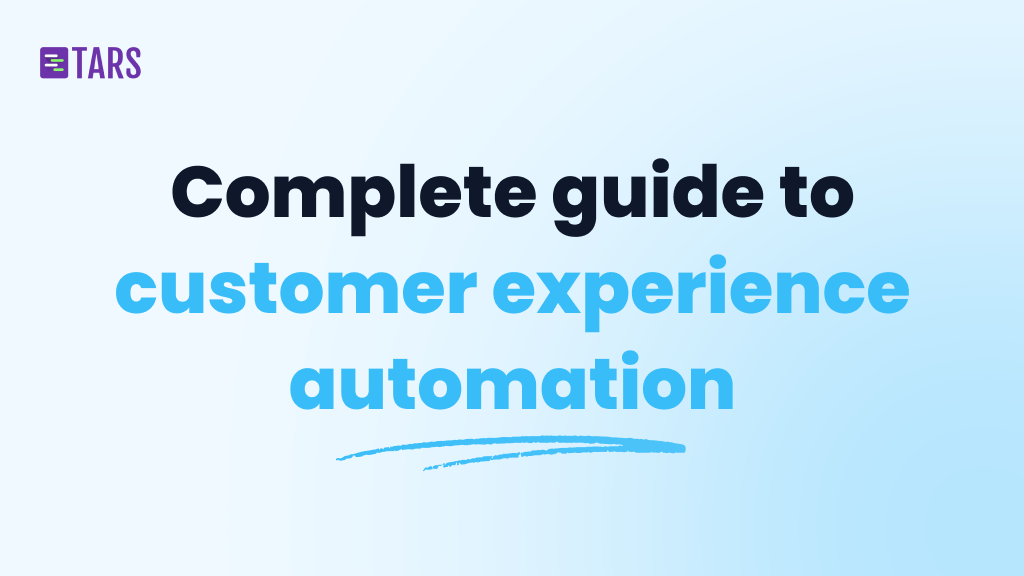
In today’s hyper-competitive business landscape, customer experience has evolved from a nice-to-have differentiator to a make-or-break factor for business success. Of companies that focus on CX, there’s an 80 percent increase in revenue. 41 percent of customer-obsessed companies achieved at least 10 percent revenue growth in their last fiscal year, compared to just 10 percent of less mature companies. As customer expectations continue to rise, demanding instant responses, personalized interactions, and seamless omnichannel support, companies face an unprecedented challenge: how to scale exceptional service without exponentially increasing costs.
Enter customer experience automation (CXA), a transformative approach that leverages artificial intelligence and advanced technologies to deliver personalized, efficient, and scalable customer experiences. This comprehensive guide explores everything you need to know about customer experience automation, from foundational concepts to selecting the right platform for your business needs.
What is customer experience (CX)?
Customer experience is every interaction someone has with your brand. It starts when they first hear about you and continues through purchase, support, and beyond. This includes browsing your website, talking to sales, using your product, contacting support, and following you on social media.
Customer experience is different from customer service. Customer service focuses on solving specific problems. Customer experience looks at the entire relationship. A good customer experience means people feel valued and supported at every step.
What makes a great customer experience:
- Personalization: Tailoring interactions based on someone’s preferences, behavior, and history
- Consistency: Providing the same quality across all channels and touchpoints
- Efficiency: Solving problems quickly without making customers work hard
- Proactivity: Fixing issues before customers notice them
- Empathy: Understanding and responding to how customers feel
Here’s why this matters: 86% of buyers will pay more for a great experience. And getting a new customer costs five times more than keeping an existing one. Investing in customer experience isn’t optional anymore.
What is customer experience automation?
Customer experience automation (CXA) uses AI, machine learning, and other technologies to improve customer interactions throughout their journey. It doesn’t replace human connection—it makes it better. CXA handles repetitive tasks and routine questions, so human agents can focus on complex issues that need empathy and judgment.
The goal is simple: deliver the right message to the right customer at the right time through the right channel. This creates experiences that feel personal while being scalable.
How we got here
Traditional customer experience relied on manual work. Support agents handled every question individually. Marketing teams sent the same emails to everyone. Businesses struggled to stay consistent as they grew.
This created problems:
- Limited hours (usually just business hours)
- Inconsistent quality depending on which agent you got
- Slow response times
- No way to personalize at scale
- High costs as volume increased
Customer experience automation fixes these issues. Modern platforms can handle thousands of conversations at once while keeping quality high. They use natural language processing to understand what customers want, machine learning to improve over time, and smart routing to connect customers with the right help.
What makes up customer experience automation
Good CXA platforms include several connected parts:
AI Agents: Advanced chatbots that understand natural language, remember context, and handle complex requests. Unlike simple bots that follow scripts, modern AI Agents can handle nuanced situations, access multiple data sources, and complete tasks like processing refunds or updating accounts.
Smart routing: Systems that analyze incoming requests and send them to the best resource—maybe a help article, an AI Agent, or a specific human agent with the right expertise. This gets customers to solutions faster.
Agent assistance tools: Real-time support that gives human agents AI-generated suggestions, customer history, sentiment analysis, and recommendations for next steps. These tools make every agent more effective without requiring them to memorize everything.
Workflow automation: Background processes that handle repetitive work like categorizing tickets, entering data, scheduling follow-ups, and managing escalations. This frees agents to focus on customers instead of admin work.
Smart Knowledge Bases: AI-enhanced help centers that spot gaps in content, suggest new articles based on common questions, and recommend the right articles based on context.
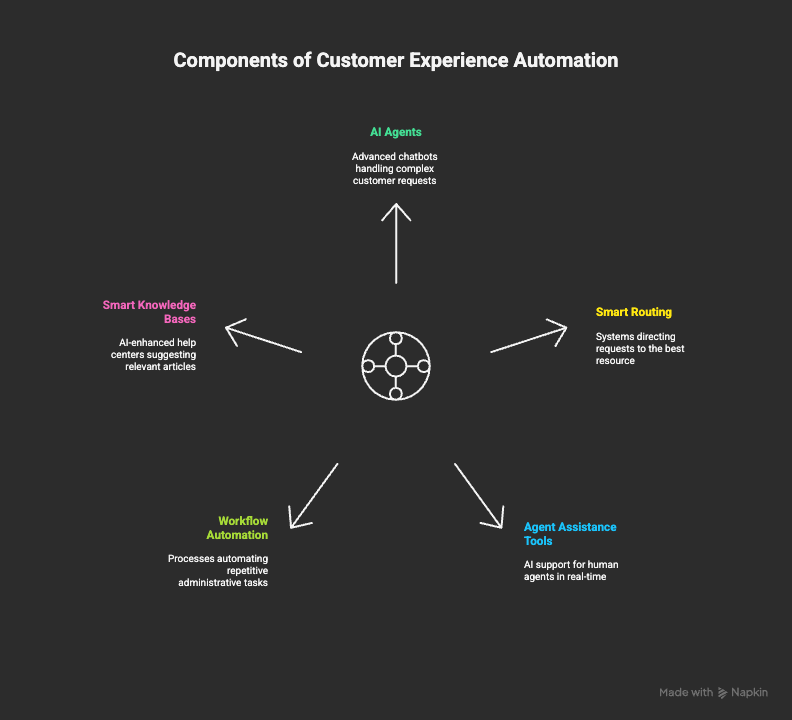
How customer experience automation works
Understanding how CXA works helps you use it better. It operates through several connected processes that create smooth, personalized experiences.
Collecting and connecting data
Good CXA needs complete customer data. Modern platforms connect with CRM systems, helpdesk software, e-commerce platforms, marketing tools, and other data sources. This creates a full picture of each customer including:
- Basic information about who they are
- What they’ve bought and when
- Previous support conversations and solutions
- How they use your website
- Which channels they prefer
- How they use your product
- Their feedback and satisfaction scores
This unified data helps automation systems understand context, personalize interactions, and decide the best way to help each customer.
Using AI and machine learning
Once you have the data, AI processes it to power automated interactions:
Natural Language Processing (NLP): Helps systems understand human language—including intent, emotion, context, and nuance. Good NLP lets AI Agents understand questions asked in countless different ways and respond appropriately.
Machine learning: Improves automation by learning from every interaction. It spots patterns in successful solutions, figures out which responses work best, and predicts what customers need based on their behavior.
Generative AI: Creates human-quality responses, generates help articles, personalizes emails, and synthesizes information from multiple sources to answer complex questions.
Taking action
With data and AI working together, CXA platforms take the right actions:
- Reaching out proactively: Sending personalized notifications, reminders, or offers based on customer behavior
- Self-service: Directing customers to relevant help articles, videos, or troubleshooting guides
- AI Agent conversations: Handling questions through chat, email, or voice
- Smart escalations: Moving complex issues to human agents with full context so customers don’t repeat themselves
- Staying consistent across channels: Keeping conversations going as customers switch from chat to email to phone
Getting better over time
The best part of CXA is how it improves continuously. Advanced platforms include:
- Performance tracking: Monitoring resolution rates, satisfaction scores, conversation quality, and efficiency
- Testing: Trying different approaches to see what works best
- Learning from feedback: Using customer ratings and agent input to refine AI behavior
- Spotting problems early: Identifying when automation performance drops and fixing it proactively
This improvement cycle means automated experiences get better over time instead of staying static.
Benefits of customer experience automation
Companies that use CXA well see real improvements—happier customers, lower costs, and better efficiency.
Better customer satisfaction and loyalty
CXA improves the customer experience through:
- Always available: AI-powered support works 24/7, so customers get help whenever they need it
- Faster solutions: Automated systems instantly access information and complete routine tasks
- Less work for customers: Smart routing and context awareness mean customers don’t have to explain their issue multiple times
- Proactive help: Systems identify and fix potential problems before customers notice
- Consistent quality: Automation makes sure every customer gets accurate, on-brand responses
Research shows that 70% of CX leaders believe AI makes digital interactions more efficient and human. 67% say AI Agents build stronger emotional connections than traditional automated systems.
Much better operational efficiency
Customer experience automation changes how support teams work:
- Handling more volume: AI Agents can manage thousands of conversations at once without quality dropping
- Less repetitive work: Automating routine questions (password resets, order status, basic troubleshooting) frees human agents for complex issues
- Better resource planning: Smart forecasting predicts demand patterns and ensures the right staffing levels
- Faster resolutions: Automated routing, suggested responses, and instant customer context help human agents solve problems faster
Companies using comprehensive CXA typically see 40-60% of routine questions handled entirely by automation. Remaining cases get resolved 30-50% faster thanks to Agent assistance tools.
Lower costs
While improving experience, CXA also cuts expenses:
- Lower labor costs: Automation handles high-volume routine questions without needing more headcount as you grow
- Less training needed: AI-powered assistance makes new agents productive faster
- Fewer escalations: Better first-contact resolution means fewer follow-ups and long support threads
- Better retention: Happier customers stay longer, reducing the high costs of getting new customers
Most companies see ROI from CXA within 6-12 months through cost savings and revenue from better retention.
Better insights
Beyond operational benefits, CXA platforms generate valuable information:
- Complete analytics: Monitoring 100% of customer conversations (versus the 2-5% typically reviewed manually) gives full visibility into sentiment, pain points, and emerging issues
- Spotting trends: Pattern recognition surfaces trending topics, common confusion points, and opportunities to improve products or services
- Performance metrics: Detailed tracking of resolution rates, satisfaction scores, automation success, and Agent performance enables data-driven improvements
- Strategic insights: Aggregated data reveals customer preferences, channel effectiveness, and opportunities to improve processes
These insights create a cycle where better data leads to better automation, which generates better data, continuously improving customer experience.
Personalization at scale
Maybe the biggest benefit of CXA is delivering personalized experiences to everyone:
- Individual recommendations: AI analyzes purchase history, browsing, and preferences to suggest relevant products or content
- Contextual responses: Automation tailors communication style, channel, and timing based on individual preferences
- Predictive engagement: Machine learning identifies the optimal moment and message for each customer
- Segment-specific experiences: Different customer groups get tailored journeys optimized for their needs
This level of personalization used to be possible only for VIP customers. CXA makes it economically viable for everyone.
Top customer experience automation platforms
The CXA landscape includes many platforms, each with different strengths. Here’s an overview of leading solutions to help you evaluate which fits your needs.
Tars: AI Agent builder for customer experience
Tars is an AI Agent builder platform designed specifically for customer support and customer acquisition automation. With 800+ clients across industries like finance, government, and healthcare, Tars focuses on rapid deployment and production-ready AI Agents.
What makes it different: Tars provides a visual drag-and-drop builder that lets teams create sophisticated AI Agents without code. The standout feature is its comprehensive testing environment, which generates synthesized test datasets to evaluate AI Agent performance before customer deployment. This ensures quality and reliability from day one. Once tested, Tars enables fast deployment across multiple platforms. The platform integrates with 600+ tools, including leading helpdesks, CRMs, and workflow platforms, making it adaptable to existing technology stacks.
Analytics and optimization: Tars provides comprehensive analytics that monitor every conversation with complete visibility. The platform tracks CX scores measuring resolution rates and sentiment analysis while identifying patterns in customer interactions. These insights enable continuous optimization of AI Agent performance and effective scaling.
Best for: Organizations that want to quickly build and deploy custom AI Agents for both support and acquisition, particularly those in regulated industries requiring robust testing and compliance capabilities.
Zendesk: Complete CX solution for the AI era
Zendesk is a comprehensive customer service platform that has evolved into a full customer experience automation solution. Their AI is built on billions of real customer service interactions, giving the platform deep understanding of customer intent and sentiment. Zendesk offers an integrated suite including AI Agents, workflow automation, Agent assistance features, and advanced analytics. Their AI is pre-trained and ready to deploy on day one with minimal setup. The platform excels at providing 24/7 automated support while seamlessly escalating complex issues to human agents with complete context.
Best for: Mid-market to enterprise companies seeking an all-in-one customer service and automation platform with proven scalability and minimal technical implementation requirements.
Fin AI: Conversational support automation
Fin AI by Intercom blends automation with human support through an advanced conversational platform. The solution focuses on resolving customer inquiries instantly while enabling smooth handoffs when human expertise is needed. Intercom’s strength is its conversational approach, designed to feel natural and human-like. Fin AI resolves routine inquiries automatically while allowing service representatives to focus on high-value conversations. The platform provides robust workflow automation and multi-channel integration, creating cohesive customer experiences across touchpoints.
Best for: Technology companies and SaaS businesses prioritizing conversational experiences and seeking to balance automation efficiency with maintaining personal customer relationships.
Forethought: Agentic AI for customer support
Forethought is a generative AI platform focused on customer support automation through its multi-Agent system. Launched in 2018, Forethought has evolved to offer autonomous AI Agents that work together across the customer journey. The platform operates through four key Agents: Solve (automatically resolves issues across channels), Triage (classifies and routes tickets), Assist (provides real-time Agent copilot support), and Discover (identifies knowledge gaps and generates content). What sets Forethought apart is its Autoflows technology—agentic AI workflows that fully resolve customer issues end-to-end without decision trees. The platform is ready on day one, trained on historical data, and can cut ticket volume by 60% or more while integrating seamlessly with major helpdesks like Zendesk and Salesforce.
Best for: Mid-market to enterprise companies seeking a comprehensive, easy-to-implement AI platform that handles the full spectrum from automated resolution to Agent assistance, particularly those wanting quick deployment without lengthy setup.
Chatbase: Simple AI Agent builder for support automation
Chatbase is an AI-powered customer support platform that focuses on simplicity and speed. Unlike complex CRM-integrated solutions, Chatbase is a standalone support automation tool that lets you build and deploy AI Agents in minutes. The platform trains on your business data (website, help docs, PDFs) and uses advanced language models from OpenAI, Claude, and Gemini to understand natural language. What makes Chatbase distinctive is its AI Actions feature, which allows Agents to take real actions like collecting leads, booking meetings, checking order status, and creating support tickets—not just answering questions. The platform is SOC 2 Type II and GDPR compliant, integrates with major platforms like Slack, Zendesk, WordPress, and Shopify, and offers flexible pricing starting at affordable tiers for startups.
Best for: Startups, small to mid-sized businesses, and scaling companies that want quick, affordable AI support automation without technical complexity or enterprise overhead. Perfect for teams needing both support and lead generation capabilities.
Salesforce Service Cloud: Enterprise CX automation
Salesforce Service Cloud is a comprehensive customer service solution deeply integrated within the Salesforce ecosystem. It leverages Customer 360 to unify sales, service, marketing, commerce, and IT data for holistic customer views. Service Cloud’s primary strength is its deep integration with Salesforce CRM and the broader Salesforce platform. This enables powerful automation workflows that span across departments and customer lifecycle stages. The platform offers sophisticated case management, extensive automation and workflow capabilities, and robust knowledge management.
Best for: Enterprise organizations already using Salesforce CRM seeking to extend automation across the entire customer lifecycle with unified data and workflows.
DevRev: AI-native support and product development platform
DevRev takes a unique approach by connecting customer support directly with product development. Built on an AI foundation, the platform helps businesses elevate support functions while bringing customer voice into product planning. DevRev’s distinctive value is its dual focus on customer support and product development. The platform provides automated ticket routing, self-service tools, and comprehensive service analytics while simultaneously enabling product teams to track how customer issues relate to product features. This creates a feedback loop where support insights directly inform product roadmaps.
Best for: Technology companies seeking to tightly integrate customer support operations with product development, particularly those building products where customer feedback directly drives feature development.
How to choose the right platform
When evaluating customer experience automation platforms, consider:
- Integration requirements: How well does the platform integrate with your existing tools (CRM, helpdesk, marketing automation, etc.)?
- Deployment speed: How quickly can you build, test, and deploy automation? Do you have technical resources for complex implementations?
- Customization needs: How much control do you need over Agent behavior, workflows, and user experience?
- Scalability: Will the platform grow with your business and handle increasing interaction volumes?
- Testing and quality: What mechanisms exist to ensure automation quality before customer deployment?
- Analytics depth: What insights does the platform provide to drive continuous improvement?
- Industry requirements: Does the platform meet compliance, security, and regulatory requirements for your industry?
Most platforms offer trial periods or demos. Test real-world scenarios relevant to your business before committing.
The future of customer experience automation
Customer experience automation keeps evolving, driven by advances in AI, changing customer expectations, and the increasing complexity of omnichannel customer journeys. Several trends are shaping the future:
Agentic AI systems: The next generation of automation moves beyond responding to requests toward proactive Agents that anticipate needs, take autonomous actions, and handle complex multi-step processes without human intervention.
Emotional intelligence: Advanced sentiment analysis and emotional AI enable systems to detect subtle emotional cues and adjust responses accordingly, creating more empathetic automated experiences.
Voice and multimodal interfaces: As voice technology improves, CXA will expand beyond text to include natural voice conversations and multimodal experiences combining text, voice, and visual elements.
Better personalization: Machine learning models will leverage increasingly sophisticated data to deliver individualized experiences that feel uniquely tailored to each customer’s preferences, context, and communication style.
Seamless human-AI collaboration: Rather than viewing automation and human service as separate channels, future CXA will create fluid experiences where AI and human agents collaborate seamlessly within the same conversation, each contributing their unique strengths.
Wrapping up
Customer experience automation represents a fundamental shift in how businesses engage with customers. It enables organizations to deliver personalized, efficient, and scalable experiences that meet rising expectations while improving efficiency and reducing costs.
The organizations winning today aren’t choosing between automation and human service. They’re strategically combining both to create experiences that are simultaneously more efficient and more genuinely human. By automating routine tasks and empowering agents with AI assistance, businesses can focus human expertise where it matters most while ensuring every customer receives fast, accurate, and personalized support.
Whether you’re just starting to explore customer experience automation or looking to enhance your existing setup, the key is starting with clear objectives, selecting the right platform for your specific needs, and staying committed to continuous improvement. The technology exists today to transform your customer experience. The question is whether you’ll adopt it before your competitors do.
Ready to build AI Agents that transform your customer experience? Explore how Tars can help you create production-ready AI Agents in minutes, not months, with comprehensive testing, seamless deployment, and actionable insights that drive continuous improvement.
A writer trying to make AI easy to understand.
- What is customer experience (CX)?
- What is customer experience automation?
- How we got here
- What makes up customer experience automation
- How customer experience automation works
- Collecting and connecting data
- Using AI and machine learning
- Taking action
- Getting better over time
- Benefits of customer experience automation
- Better customer satisfaction and loyalty
- Much better operational efficiency
- Lower costs
- Better insights
- Personalization at scale
- Top customer experience automation platforms
- Tars: AI Agent builder for customer experience
- Zendesk: Complete CX solution for the AI era
- Fin AI: Conversational support automation
- Forethought: Agentic AI for customer support
- Chatbase: Simple AI Agent builder for support automation
- Salesforce Service Cloud: Enterprise CX automation
- DevRev: AI-native support and product development platform
- How to choose the right platform
- The future of customer experience automation
- Wrapping up


Build innovative AI Agents that deliver results
Get started for freeRecommended Reading: Check Out Our Favorite Blog Posts!
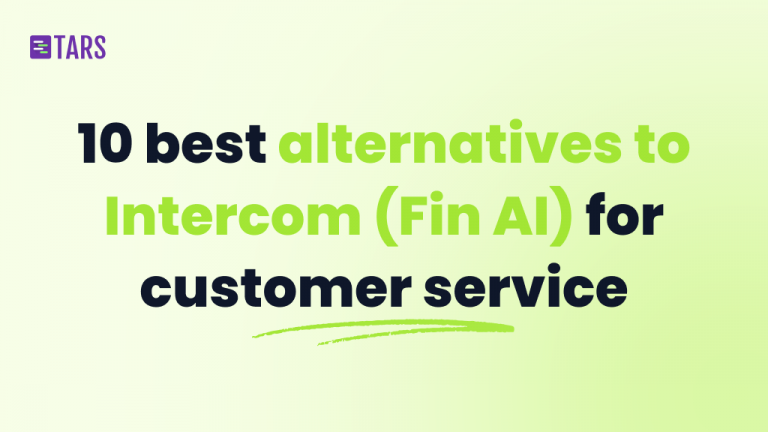
10 best alternatives to Intercom (Fin AI) for AI-powered customer service [2025]
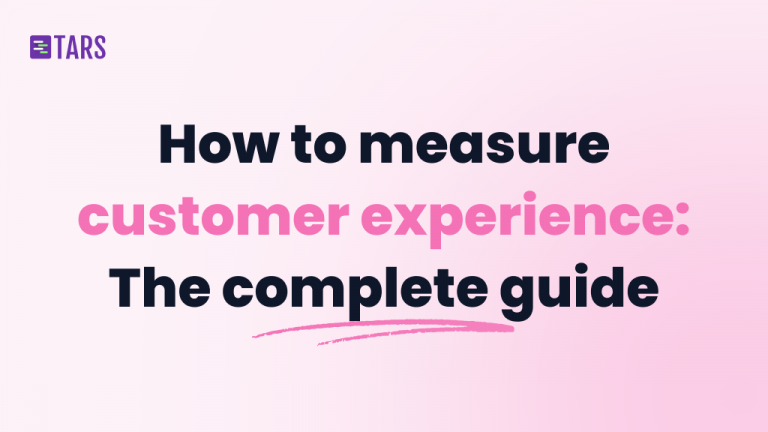
How to measure customer experience: The complete guide for AI-powered support and growth
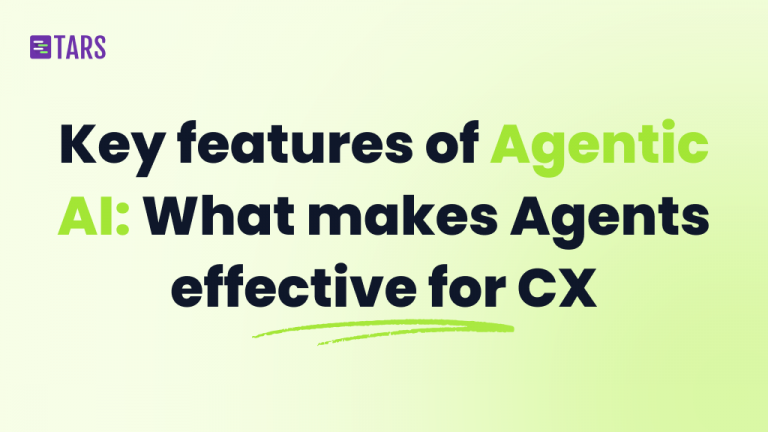
Key features of Agentic AI: What makes AI Agents effective for customer experience

Our journey in a few numbers
With Tars you can build Conversational AI Agents that truly understand your needs and create intelligent conversations.
years in the conversational AI space
global brands have worked with us
customer conversations automated
countries with deployed AI Agents






